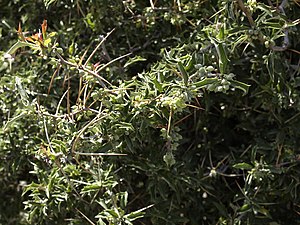Berberis chilensis
| Berberis chilensis | ||||||||||||
|---|---|---|---|---|---|---|---|---|---|---|---|---|

Berberis chilensis |
||||||||||||
| Systematics | ||||||||||||
|
||||||||||||
| Scientific name | ||||||||||||
| Berberis chilensis | ||||||||||||
| Gillies ex Hook. & Arn. |
Berberis chilensis is a species of plant from the family of Barberry (Berberidaceae). She is from Chile .
description
Berberis chilensis grows as a shrub and reaches heights of up to two meters. The bark of young twigs is smooth and reddish-brown, sometimes blue-green in color; with age it turns gray and then has a more or less fibrous appearance. The thorns are one to three-part, the thorn branches between 0.5 and 5.5 centimeters long.
The 0.5 to 5 centimeters long and 0.7 to 2.5 centimeters wide leaves are elliptical to ovate-lanceolate in shape and either arched lengthways. The upturned or flat with downwardly bent leaf margins usually have one to five thorn-pointed teeth. The petiole is up to 8 millimeters long.
The racemose inflorescence is 1 to 5 centimeters long and consists of 10 to 30 flowers. The lemon-yellow, 3 to 5 millimeter long flowers contain 11 to 14 bracts and the flower stalks are 3 to 5 millimeters long. The spherical fruits are 5 to 7 millimeters long, have a 1 to 2 millimeter long style and contain one to three seeds that are 4 to 5 millimeters long.
Common names
In Chile this type of plant is called michay , richa , palo amarillo or espino maulino .
Systematics
The description of the species was given in 1832 by John Gillies in William Jackson Hookers and George Arnott Walker Arnotts Bot. Misc. 3: 135 published.
Varieties
Landrum distinguishes between two varieties of Berberis chilensis :
- Berberis chilensis var. Chilensis
- This variety has curved leaves with upturned leaf margins; the edges themselves are not bent. The teeth on the leaf margin are 2 to 7 millimeters long, the thorns are 1 to 5.5 centimeters long. The plants of this variety bloom in September and October and produce fruit from November to March. This variety is endemic in Chile from the Región de Coquimbo to the Región de la Araucanía . It grows there at altitudes between 370 and 1600 m above sea level.
- Berberis chilensis var. Brachybotria ( Gay ) Landrum
- This variety has almost flat leaves with the leaf margins bent slightly downwards. The spike-tip teeth on the leaf margin are 1 to 2 millimeters long. The thorns are 1 to 2.5 inches long. The plants of this variety bloom from August to September and produce fruit from October to January. This variety is endemic in Chile in the coastal Cordillera and on the coast of the Región de Coquimbo to the Province of Colchagua .
Synonyms
Many synonyms are known for this species and its varieties :
- Berberis brachybotrys Gay
- Berberis brachybotria Gay
- Berberis brachybotria var. Brevispina rich
- Berberis chilensis var. Diffusa (Gay) Rich
- Berberis chilensis var. Ferox (Gay) Rich
- Berberis diffusa Gay
- Berberis ferox Gay : The description of the species was given in 1832 by John Gillies in William Jackson Hookers and George Arnott Walker Arnotts Bot. Misc. 3: 135 published.
- Berberis fragrans Phil. Ex Reiche
- Berberis gayi K. Koch
Web links
- Berberis chilensis on www.chilebosque.cl (span.)
- Berberis chilensis var. Chilensis on www.chileflora.com
- Identification key of the Chilean Berberis species and description of this species. (Spanish; PDF file; 2.05 MB)
swell
- Leslie R. Landrum: Revision of Berberis (Berberidaceae) in Chile and Adjacent Southern Argentina . In: Annals of the Missouri Botanical Garden . tape 86 , no. 4 , 1999.
- Leslie R. Landrum: Berberidaceae . In: Flora de Chile . Vol. 2 (2), 2003.